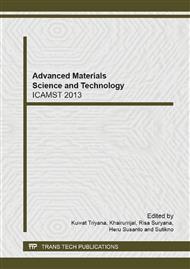p.3
p.7
p.20
p.24
p.29
p.33
p.37
p.41
Mass Production of Stacked Styrofoam Nanofibers Using a Multinozzle and Drum Collector Electrospinning System
Abstract:
Electrospinning offers the unique ability to produce fibers with very small diameters down to a few tens of nanometers and an attractive mechanical appearance as well as the controllability of morphology, surface and pores structure. However, the main drawback of the conventional electrospinning technique is its low productivity. In order to produce high yield nanofibers, the production rate of nanofibers must be improved. The multinozzle and drum collector electrospinning system was then developed to overcome the problem. The multinozzle sub-system was used to increase the production rate of nanofibers while the drum collector was utilized to maintain the uniformity and thickness of stacked nanofibers. A solution prepared by dissolving waste styrofoam in the mixture of tetrahydrofuran (THF), citronella oil and cajuput oil was the precursor to produce the stacked styrofoam nanofibers.
Info:
Periodical:
Pages:
20-23
Citation:
Online since:
February 2014
Price:
Сopyright:
© 2014 Trans Tech Publications Ltd. All Rights Reserved
Share:
Citation:


